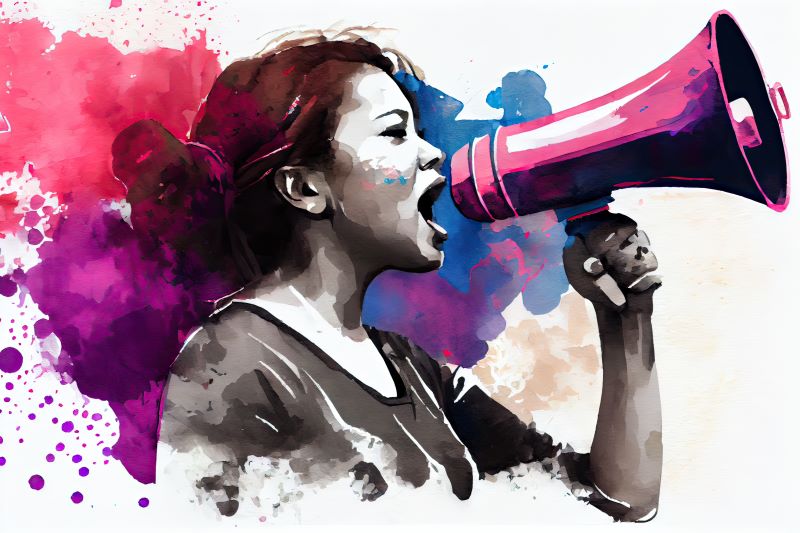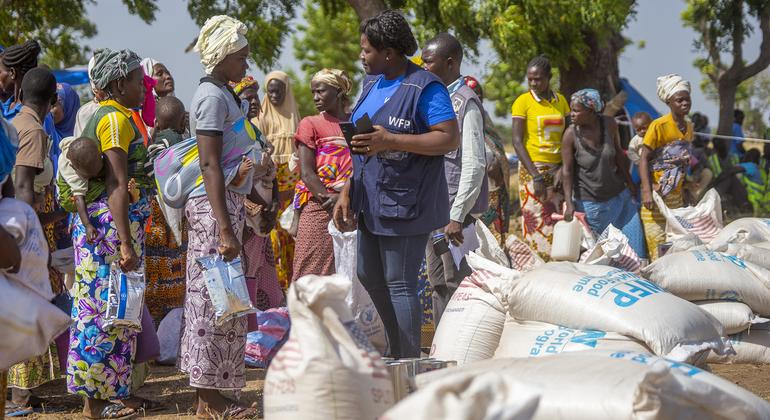Reproductive justice centers on four core values: the right to personal bodily autonomy, the right to have kids, the right to not have kids, and the right to raise kids in healthy, safe environments.
For centuries, people have fought for the right to not have children, the right to have children, and the right to parent in healthy, safe environments. While it’s often confused with reproductive rights, “reproductive justice” is a more comprehensive framework that addresses the gaps and weaknesses in the reproductive rights movement. In this article, we’ll define reproductive justice, provide examples of reproductive justice, and explore where you learn more about this critical human rights framework.
While reproductive rights tend to focus on legal and political reproductive rights like birth control and abortion, the reproductive justice framework expands to the intersectional issues affecting reproductive autonomy, like race, gender, class, power, and access.
Definitions: what is reproductive justice and how does it differ from reproductive rights?
Reproductive rights and reproductive justice are similar, but their differences are important. Reproductive rights refer to an individual’s legal and political rights to make their own reproductive healthcare decisions without force or interference from governments, institutions, and other individuals. While the Universal Declaration of Human Rights doesn’t explicitly mention reproductive rights, articles like Article 12 (the right to privacy) and Article 25 (which gives motherhood and childhood special care and assistance, as well as the universal right to medical care and necessary social services) cover sexual and reproductive rights. Within international human rights law, reproductive rights like accessing contraception, abortion, healthcare services, and fertility treatments are considered essential human rights.
Reproductive justice is based on the belief that reproductive rights are not enough to protect full reproductive autonomy. In 1994, a group of Black women met in Chicago and coined the term “reproductive justice.” It was a direct response to the failures of the women’s rights movement, which had centered middle-class and wealthy white women and left women of color, trans people, and other marginalized groups behind. The term was also created to emphasize the need for access – not just choice – as well as resources and services like contraception, comprehensive sex education, domestic violence assistance, and adequate wages.
In 1997, SisterSong became a national, multi-ethnic reproductive justice movement. Reproductive justice has four core demands, which we quote from this page:
- The human right to own our bodies and control our future
- The human right to have children
- The human right to not have children, and
- The human right to parent the children we have in safe and sustainable communities.
Reproductive justice focuses on analyzing economic, political, and social power systems; centering the most marginalized; and addressing intersecting oppressions related to race, class, gender, sex, and more. While reproductive rights are basic political and legal protections, reproductive justice seeks to create a path to liberation.
What are some examples of reproductive justice?
Reproductive justice is a comprehensive framework, but here are three important examples:
Access to birth control and abortion
Birth control and abortion are linked to the right to decide when to have children or to not have children at all. Birth control methods have existed since ancient times, and by 1900, various forms of birth control were widely used. Margaret Sanger (the United States) and Marie Stopes (England) were leaders in the birth control movement, which sought to make birth control legal and accessible. Unfortunately, some of their motives were based in eugenics. As an example, Sanger promoted birth control as a way to limit the reproduction of poor and “feeble-minded” people. Despite the beliefs of its famous proponents, accessible birth control was – and remains – essential to reproductive justice. Oral contraceptives (the pill) became legal nationwide in the United States in 1965 thanks to Griswold v. Connecticut, which ruled that banning birth control violated a couple’s right to privacy. According to the World Health Organization, 842 million “women of reproductive age group” (which is those between 15-49 years old) are using contraceptive methods globally while 270 million need access to contraception.
Abortion has always been around, but by the end of the 19th century, it was illegal almost everywhere in the world. As the 20th century began, countries started to change their laws. As with birth control, the arguments for abortion were not always focused on human rights, but on overpopulation, poverty, and fetuses with disabilities. Modern arguments for abortion have focused more on bodily autonomy and the health of child-bearing persons. Abortion rights have expanded significantly in the past decades. Restrictions exist, but according to the Center for Reproductive Rights, around 59% of women of reproductive age live in countries that “broadly allow” abortion. Choosing when to have kids, when to not have kids, and when to end a pregnancy are critical to an individual’s autonomy, health, and economic well-being, as well as the well-being of families.
Access to comprehensive sex education
Comprehensive sex education is critical to a young person’s development and health. It doesn’t only cover sexual intercourse; good sex education covers a variety of topics. The American Academy of Pediatrics lists subjects such as:
- Body anatomy
- Body image
- Sexual orientation and gender identity
- Consent
- Sexual abuse
- Contraception
- Sexually-transmitted infections
- Reproductive rights and responsibilities
Curriculums vary across the world, but comprehensive sex education should always use evidence-based, medically-accurate information. Students should also get opportunities for safe discussions about topics they encounter in programs. Studies show that comprehensive sex education promotes healthy sexual behaviors, supports an individual’s social-emotional learning, and helps them form healthy, safe relationships. Because sex education should ideally begin when kids are young, it’s often the first form of reproductive justice they’ll encounter. Everyone deserves the same quality of education. Many lack even the most basic information; according to UNESCO, around ⅔ girls in many countries don’t have the information they need when they begin menstruating. UNESCO also found that around 71% of individuals aged 15-24 were looking for sexual education online. The internet represents a space where reproductive justice activism and comprehensive sex education can make a big difference.
Access to pregnancy-related healthcare
As the UDHR makes clear, child-bearing persons and children are entitled to special care. Healthcare is especially important as pregnancy comes with many health risks. The WHO describes how in 2020, around 287,000 child-bearing persons died during and after pregnancy and childbirth. 95% of these deaths happen in low and lower-middle-income countries. Injuries and death come from excessive blood loss, high blood pressure, and infections, as well as conditions like heart disease and malaria. With proper healthcare, most of these deaths are preventable.
What does proper pregnancy-related healthcare look like? The quality of health services is vital, which includes the supply of essential drugs, equipment, and supplies.
Healthcare providers also need proper training in both medical care and gender-inclusive care (trans men and nonbinary persons give birth), as well as adequate facilities. Integrating care with community events can also improve access to healthcare. Equity regarding race and pregnancy needs to be addressed, too. Black women in the UK are four times more likely to die in childbirth while in the US, they’re around three times more likely. Ensuring equal care saves lives and protects the health of adults, babies, and entire families.
Where can you find more learning opportunities about reproductive justice?
If you’re interested in learning more about reproductive justice, courses and books are a great place to start. Here are five courses and five books:
International Women’s Health and Human Rights (Stanford)
| Length: 10 weeks | Mode: Self-paced | Commitment: 1-6 hours per week | Level: Beginner |
This is a great choice if you’re interested in women’s health and human rights issues from infancy through old age. Consulting Professor Anne Firth Murray and Kevin Hsu created the course. Topics covered include reproductive health, women in war and refugee settings, violence against women, and women’s rights as human rights. There are no prerequisites.
Confronting Gender Based Violence: Global Lessons for Healthcare Workers (John Hopkins University)
| Length: 4 weeks | Mode: Self-paced | Commitment: 5-6 hours per week | Level: Beginner |
This course introduces students from the healthcare sector to gender-based violence, health outcomes, seminal research, and clinical best practices for violence prevention, support, and management. Michele Decker (Scd, MPH) from the Department of Population, Family, and Reproductive Health teaches the course. There are no prerequisites.
Menstruation in a Global Context: Addressing Policy and Practice (ColumbiaX)
| Length: 14 weeks | Mode: Self-paced | Commitment: 2-3 hours per week | Level: Beginner |
This course gives students a foundational understanding of the global menstruation movement, which includes menstrual health and hygiene research, programming, and policies. Students will also gain skills and knowledge about designing MHH programs, researching, monitoring, and advocacy. Marni Sommer, Maggie L. Schmidt, and Caitlin Gruer teach the course.
Religion and Sexual Wellbeing: Pleasure, Piety, and Reproductive Rights (University of Groningen)
| Length: 4 weeks | Mode: Self-paced | Commitment: 3 hours per week | Level: Beginner |
This course explores sexuality as a private and public affair, the differences between religion as a lived experience and as a prescription from religious authorities, and the dynamics of the polarization around reproductive rights. Students will also reflect on the different contexts in which people gain sexual knowledge and how to support people in their sexual health and wellbeing. Kim Knibbe, Brenda Bartelink, and Rachel Spronk teach the course. There are no prerequisites.
Improving The Health of Women, Children, and Adolescents: from Evidence to Action (London School of Hygiene & Tropical Medicine)
| Length: 6 weeks | Mode: Self-paced | Commitment: 4 hours per week | Level: Beginner |
In this course, students will learn from experts about improving the health of women, children, and adolescents. Topics include reproductive health, the health of people during pregnancy, newborns, stillbirths, and children’s health. It’s a great choice for healthcare professionals or anyone interested in the subject. Joy Lawn teaches the course.
Killing the Black Body: Race, Reproduction, and the Meaning of Liberty (1998)
Dorothy Roberts
This iconic book exposes America’s systemic abuse of Black women’s bodies and how mainstream feminist and civil rights agendas have excluded Black women’s reproductive needs.
Birthing Liberation: How Reproductive Justice Can Set Us Free (2023)
Sabia Wade
This book addresses the intersections of systemic issues, like access to healthcare, housing, and nutrition, as they relate to reproductive justice. Written by a radical doula and educator, the book argues that reproductive justice is the key to collective liberation and equity.
Undivided Rights: Women of Color Organizing for Reproductive Justice (2016)
Marlene Geber Fried, Elena R. Gutiérrez, Jael Silliman, Loretta J. Ross
Through research, case studies, and personal interviews, this book describes how women of color have led the fight for reproductive justice.
A Woman’s Life is a Human Life: My Mother, Our Neighbor, and the Journey from Reproductive Rights to Reproductive Justice (2023)
Felicia Kornbluh
This book covers the history of two movements in New York: the right to decriminalize abortion and the fight against sterilization abuse. Kornbluh tells the story of her mother, who wrote the first draft of New York’s law decriminalizing abortion, and their neighbor, a doctor who co-founded the movement against sterilization abuse.
Just Get On the Pill: The Uneven Burden of Reproductive Politics Vol. 4 (2021)
Krystale E. Littlejohn
This book covers the social history and social implications of birth control, how it becomes gendered, and why it creates an unbalanced, unjust approach to pregnancy prevention.
Did you find this article useful? Sign up to our newsletter for paid human rights internships, online courses, master’s degrees, scholarships and other human rights opportunities.







